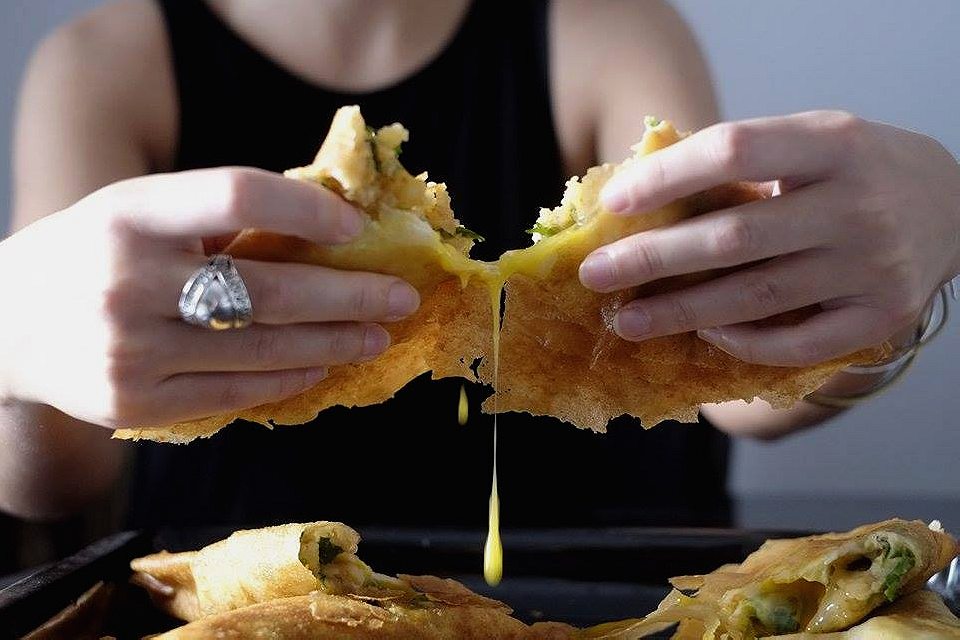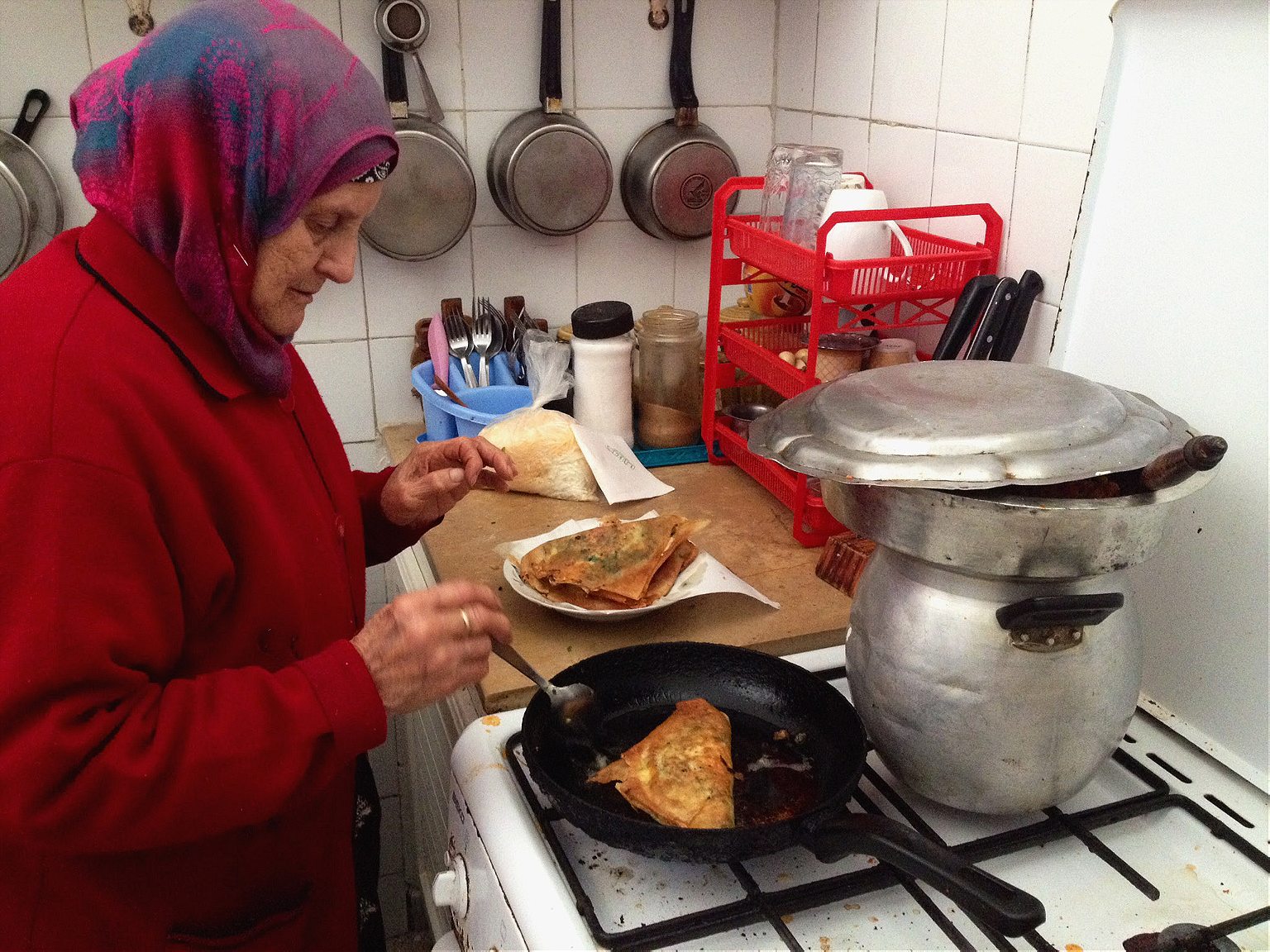Skip the ubiquitous supermarket version and gorge on the crispy, yolky, dripping-with-oil brik that writer Sarah Souli’s grandmother makes.
It is my steadfast belief that every great food culture has a dumpling, utilizing the looser definition of the term: a filling wrapped in a carb. Argentinian empanada, Polish pierogi, Jiangnan xiao long bao, Greek mpougatsa, Japanese gyoza, Nepalese momo, Indian samosa, a Boston cream doughnut… the list, thankfully, is endless.
The North African country of Tunisia has its own version, too—here, we gorge on brik a l’oeuf, a triangle shaped, deep-fried pastry. My own grandmother, Memeti, has been making me brik since I was a child. My most visceral memory is of her standing in the kitchen, cracking a raw egg into the brik wrapper. Barely at eye level with the stove, I would watch the brik bob up and down in the oil; I was so impatient to eat it, I would often burn the roof of my mouth. As a kid, I would only eat brik during summer visits to Tunisia. Now that I live here, I’ve taken it upon myself to eat them constantly.
Brik first starts with a paper-thin pastry sheet. Tunisian Jews call the wrapper a warqa, which means ‘paper’ in Arabic. Muslims refer to it as malsouka; both words can be used interchangeably. Now mass-produced and sold in supermarkets, the best wrappers are of course handmade, and can still be bought at local markets.
Next comes a small mound of filling with a depressed crater at its peak, to make room for an egg. The whole thing is gingerly folded in half and dropped into a vat of simmering oil, where it is deep fried to crispy perfection. It’s best to eat it hot, with a generous squeeze of fresh lemon.

Brik is ubiquitous across Tunisia, although its origins are murky. The word ‘brik’ possibly comes from the Turkish word börek, a baked phyllo pastry stuffed with a savory filling. The Turkic root of börek, ‘bur,’ means ‘to twist.’ (The French bit, l’oeuf, meaning ‘with egg,’ is a relic from French colonization.) From the 16th to 19th centuries, Tunisia was a province of the Ottoman Empire; the Ottoman influence is still tangible in Tunisia, particularly in architecture.
They might have had a semantic impact on brik, but there’s nothing Turkish about the technique or taste of Tunisia’s national dumpling. It’s more likely that it originated in or around southern Tunisia, and was the culinary work of Tunisian Jews, although even making those claims are contentious and secondary to the deliciousness of brik.
“Libyan Jews say they started it, but I was in Tripoli and there was nothing there, not even one person making it in the street,” Rafram Chaddad Boaz, a Jewish artist from the Tunisian island of Djerba, told me. Boaz, who has a mess of dark brown curls and a few days worth of stubble, is one of those truly colorful characters you only meet a handful of times in life. He grew up in Jerusalem, consciously objected to military service, founded Slow Food Israel, and spent some time in a Libyan prison after being wrongly accused of plotting to assassinate Muammar Gaddafi (he was in the country to photograph Jewish heritage sites). Last year, he returned to his motherland, where, among other things, he informally acts as the country’s in-house food historian. His own brik recipe was included in Yottam Ottolenghi’s Jerusalem cookbook.
“It’s a very hard thing to trace,” he continued. “They say it’s at least 500 years old… everything is new and old, anyway. Brik is more new.” However, and wherever brik started, it caught on quickly, and it’s now eaten across the country. There are regional varieties to the filling, indicating that as the food spread, people utilized what was around them to stuff their brik. Until cheaper oil alternatives were brought into the country, olive oil was the frying oil of choice.

Boaz makes his brik the Djerbian way, with a filling consisting of potato, parsley, and harissa, a spicy condiment made of peppers and spices. Curious to try his recipe, I invited myself over to his temporary flat in La Goulette, a coastal suburb of Tunis that was historically home to the majority of the city’s Jewish population. There’s a strip of seafood restaurants behind the beach that all serve the same menu: vegetable salad, brik a l’oeuf, fish and barley soup, and grilled fish. They’re not the best examples of brik, though—they skimp on the filling and often overcook the pastry, so the yolk becomes hard and chalky.
Boaz had already cooked, peeled, and cooled a dozen waxy potatoes by the time I arrived. He mashed the potatoes with a handful of parsley, salt, harissa, and chopped sweet lemons he preserves himself. He lamented at the lack of innovation in Tunisian cuisine—culinary changes are steadfastly ignored in favor of traditional recipes.
It’s a complaint I also heard from Fabienne Viner-Luzzato, a French Tunisian Jew who now runs cooking classes in London. “I believe that today food has to evolve… it needs to be more healthy, we need to be more conscious. Why do you have to fry a brik a l’oeuf? I bake them,” she told me, acknowledging that her very traditional sister-in-law was mortified to hear that any brik could end up in the oven.
The yolk is always, always runny
For many Tunisians, eating brik—that oily shatter of the crispy crust, the dripping, unctuous yolk—is such a sensory experience, tradition must be held onto. Nothing, after all, could compare to our parents’ or grandparents’ cooking.
After a series of protests rocked Tunisia over the winter, a countrywide curfew was imposed. I paid an afternoon visit to Memeti before I would have to scurry home, quarantined in my house until the next morning. She would not let me leave until she had deep-fried six brik, a wave of paper towels stacked between them to absorb the oil. She makes them the northern way—or at least, her way: no potatoes or harissa, a generous amount of tuna fish, capers, parsley, and just a little bit of grated cheese, served with a wedge of fresh lemon. The yolk is always—always—runny. She placed them in a plastic bag and sent me home, urging me to be careful and to never, God forbid under any circumstance, go hungry.

Brik a l’oeuf
Quantities depend on how much you want to make. Making brik is a method of taste and touch; things are measured in pinches and palms. Feel free to experiment—you might find that you want to add caramelized onion or garlic, different fresh herbs, or seafood or meat.
Malsouka wrappers (you can also use several layers of phyllo dough or wonton wrappers)
1-2 cups of sunflower oil
Eggs
For Memeti’s filling:
1 can of tuna fish (packed in olive oil)
1 tablespoon of capers
Handful of parsley
Handful of grated white cheese
Salt and pepper, to taste
For Boaz’s filling:
1 lb of potatoes
1 tablespoon of harissa (to taste)
Handful of parsley
1 tablespoon of preserved lemon (to taste)
Salt and pepper, to taste
To make Memeti’s filling:
Step 1: Drain the tuna fish, and chop the parsley and capers.
Step 2: In a small bowl, mix together the tuna fish, parsley, capers, cheese, and salt and pepper. Taste and adjust accordingly to your preferences.
To make Rafram’s filling:
Step 1: Bring a large pot of salted water to a boil. Add the potatoes and cook until tender, 20-30 minutes depending on their size. Peel and cool.
Step 2: Chop a small handful of parsley and a tablespoon of preserved lemon.
Step 3: Mash about two cups of potatoes and add the parsley, preserved lemon, and harissa. Taste and add pepper and salt (the preserved lemon is already very salty, so be careful!).
To assemble the brik:
Step 1: Pour the oil in a deep pan. The oil should reach about two-thirds up the pan—more is better, as the brikwill fry faster and retain less oil. When the oil is simmering (not boiling!), it’s ready.
Step 2: Place a malsouka in a shallow dish (this will make it easier to manipulate). Depending on how thin your wrapper is, you may need to double up. Place two to three large spoonfuls of the filling in the middle of the malsouka.
Step 3: Using the back of your spoon, make a dent in the filling. Crack the egg and gently place it in the dent.
Step 4: Carefully fold the brik into a half-moon shape, and drop it in the oil. Brik are like pancakes; the first one is guaranteed to be terrible, but keep making them until you get the hang of it.
Step 5: Using a spoon, pour hot oil onto the topside of the brik, so that it cooks evenly. After about a minute and a half (or until the crust becomes golden brown) remove the brik. Repeat until you’ve used up all your filling.
Serve immediately, with fresh parsley and lemon wedges.
Top image: Rusty Clark.